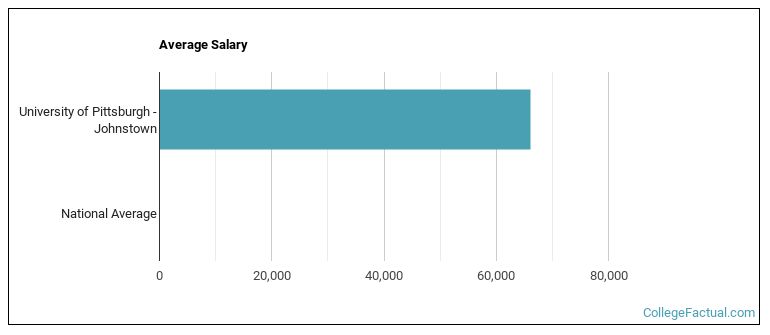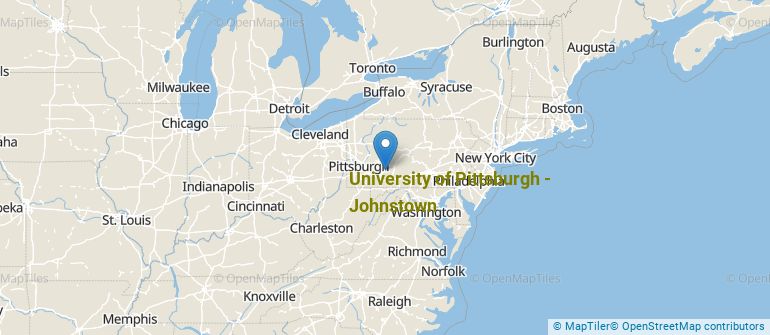 by our College Data Analytics Team
by our College Data Analytics TeamCollege Factual analyzes over 2,000 colleges and universities in its annual rankings and ranks them in a variety of ways, including most diverse, best overall quality, best for non-traditional students, and much more.
University of Pittsburgh - Johnstown was awarded 23 badges in the 2025 rankings. The highest ranked major at the school is marketing.
Explore the best ranked schools for the programs you are most interested in.
Pitt Johnstown landed the #1,157 spot in College Factual's 2025 ranking of best overall colleges in the United States. The higher ed experts analyzed 2,152 colleges and universities across the nation to determine this ranking. This is an improvement over the previous year, when Pitt Johnstown held the #1,336 spot on the Best Overall Colleges list.
Out of the 103 colleges in Pennsylvania, Pitt Johnstown is ranked at #67.
See all of the rankings for University of Pittsburgh - Johnstown.
Because it has a high acceptance rate of 97%, some consider Pitt Johnstown to be a safety school. But don't just assume that admittance is in the bag. Make sure to spend enough time on your application so that it is in tip-top shape.
About 55% of students accepted to Pitt Johnstown submitted their SAT scores. When looking at the 25th through the 75th percentile, SAT Evidence-Based Reading and Writing scores ranged between 520 and 570. Math scores were between 520 and 630.
Learn more about University of Pittsburgh - Johnstown admissions.
The student to faculty ratio at University of Pittsburgh - Johnstown is about average at 15 to 1. This ratio is often used to gauge how many students might be in an average class and how much time professors will have to spend with their students on an individual level. The national average for this metric is 15 to 1.
Another measure that is often used to estimate how much access students will have to their professors is how many faculty members are full-time. The idea here is that part-time faculty tend to spend less time on campus, so they may not be as available to students as full-timers.
The full-time faculty percentage at University of Pittsburgh - Johnstown is 91%. This is higher than the national average of 47%.
The freshmen retention rate of 76% tells us that most first-year, full-time students like University of Pittsburgh - Johnstown enough to come back for another year. This is a fair bit higher than the national average of 68%. That's certainly something to check off in the good column about the school.
The on-time graduation rate is the percent of first-time, full-time students who get their bachelor's degree with four years. At Pitt Johnstown this rate is 37%, which is about average when compared to the national rate of 33.3%.
Find out more about the retention and graduation rates at University of Pittsburgh - Johnstown.
During the 2017-2018 academic year, there were 2,356 undergraduates at Pitt Johnstown with 2,294 being full-time and 62 being part-time.
| $0-30 K | $30K-48K | $48-75 | $75-110K | $110K + |
|---|---|---|---|---|
| $10,381 | $11,409 | $16,861 | $21,571 | $23,530 |
The net price is calculated by adding tuition, room, board and other costs and subtracting financial aid.Note that the net price is typically less than the published for a school. For more information on the sticker price of Pitt Johnstown, see our tuition and fees and room and board pages.
It's not uncommon for college students to take out loans to pay for school. In fact, almost 66% of students nationwide depend at least partially on loans. At Pitt Johnstown, approximately 62% of students took out student loans averaging $8,262 a year. That adds up to $33,048 over four years for those students.
Get more details about paying for University of Pittsburgh - Johnstown.

See which majors at University of Pittsburgh - Johnstown make the most money.
Get more details about the location of University of Pittsburgh - Johnstown.

Contact details for Pitt Johnstown are given below.
| Contact Details | |
|---|---|
| Address: | 450 Schoolhouse Road, Johnstown, PA 15904 |
| Phone: | 814-269-7000 |
| Website: | www.upj.pitt.edu/ |
| Most Popular Majors | Bachelor’s Degrees | Average Salary of Graduates |
|---|---|---|
| Teacher Education Grade Specific | 56 | $36,248 |
| Civil Engineering | 52 | $66,943 |
| Mechanical Engineering | 52 | $71,406 |
| Marketing | 32 | $46,239 |
| General Psychology | 32 | $34,377 |
| General Biology | 29 | $33,576 |
| Writing Studies | 26 | $35,700 |
| Computer Science | 20 | $77,599 |
| Information Science | 20 | $59,951 |
| Chemical Engineering | 20 | $73,072 |
Online learning is becoming popular at even the oldest colleges and universities in the United States. Not only are online classes great for returning adults with busy schedules, they are also frequented by a growing number of traditional students.
In 2022-2023, 23 students took at least one online class at University of Pittsburgh - Johnstown. This is an increase from the 1 students who took online classes the previous year.
| Year | Took at Least One Online Class | Took All Classes Online |
|---|---|---|
| 2022-2023 | 23 | 1 |
| 2021-2022 | 1 | 1 |
| 2020-2021 | 8 | 0 |
| 2018-2019 | 1 | 0 |
Learn more about online learning at University of Pittsburgh - Johnstown.
If you’re considering University of Pittsburgh - Johnstown, here are some more schools you may be interested in knowing more about.
Curious on how these schools stack up against Pitt Johnstown? Pit them head to head with College Combat, our free interactive tool that lets you compare college on the features that matter most to you!
Footnotes
*The racial-ethnic minorities count is calculated by taking the total number of students and subtracting white students, international students, and students whose race/ethnicity was unknown. This number is then divided by the total number of students at the school to obtain the racial-ethnic minorities percentage.
References
More about our data sources and methodologies.